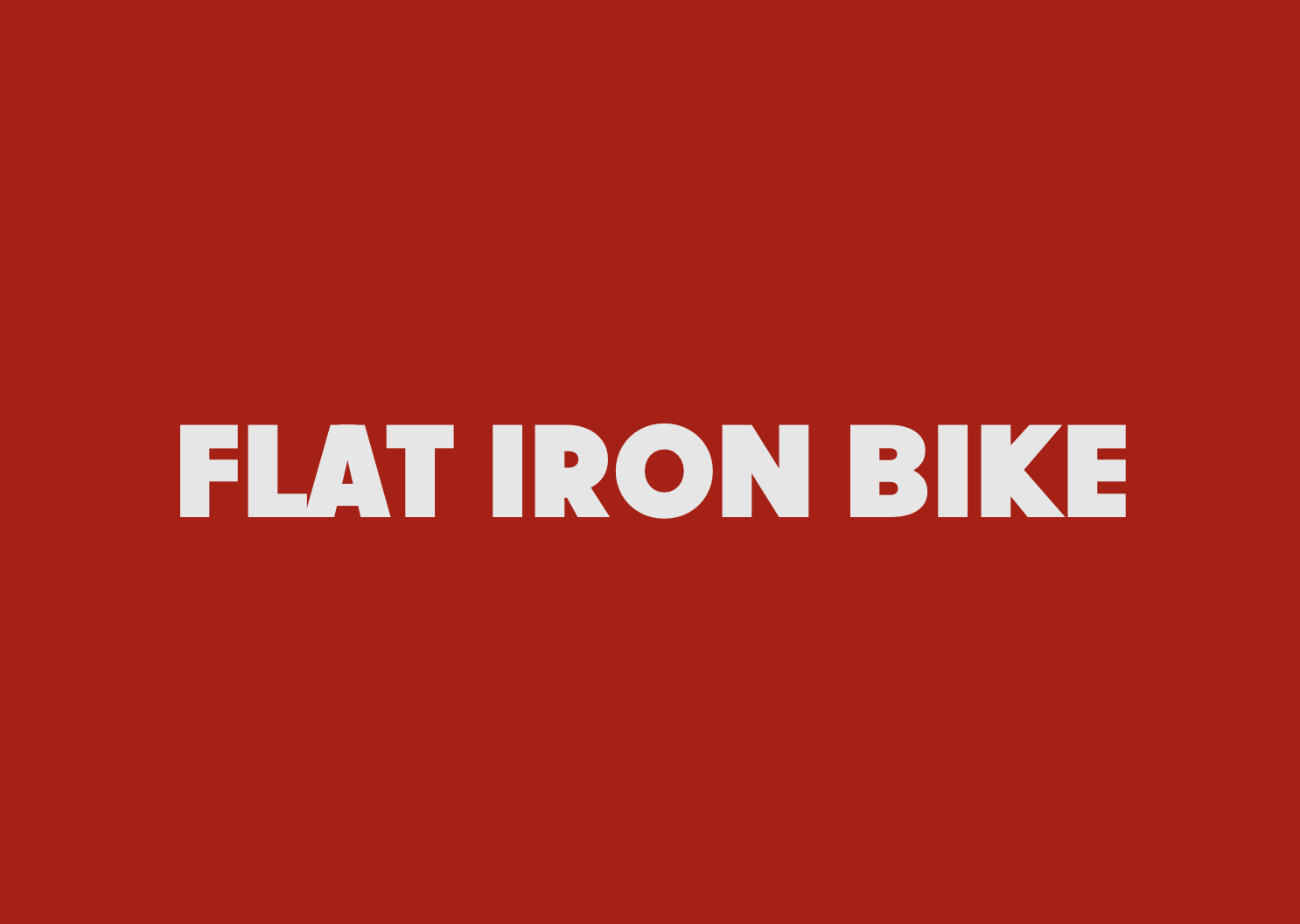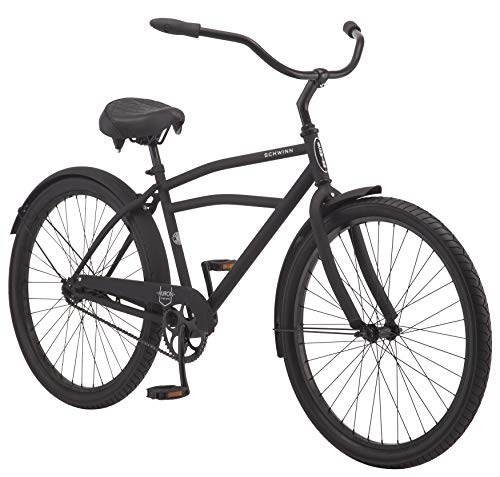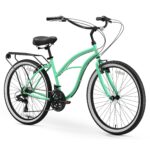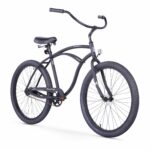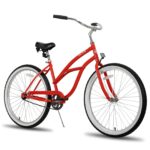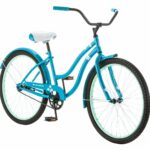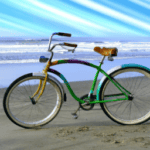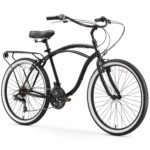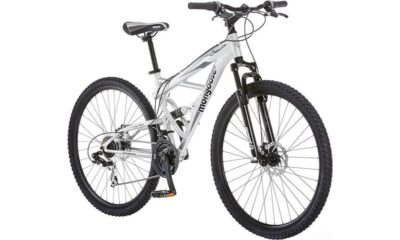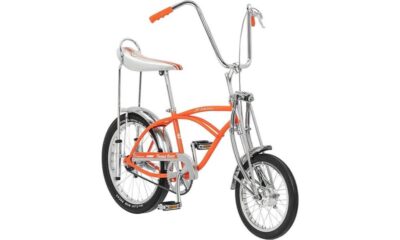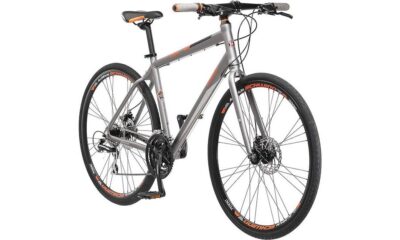Beach Cruiser
What to Look For in a Beach Cruiser
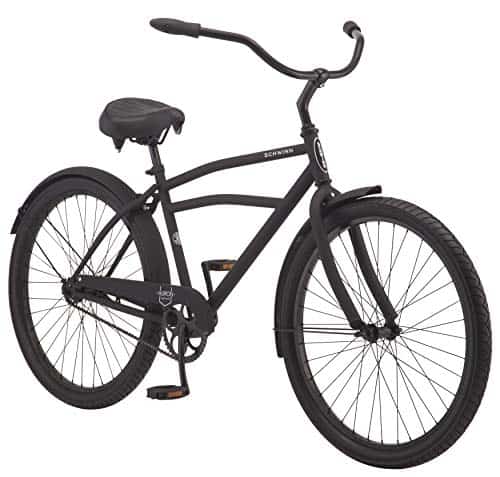
Locating the ideal beach cruiser becomes an easy task when you opt for one constructed from aluminum or steel. Essential characteristics to seek out comprise a single-speed gear mechanism, single-tree forks, a step-over frame design, platform pedals, and an included front basket. Additional features worth considering for a beach cruiser are a step-through frame for effortless mounting and dismounting, along with fenders. The seat and sidewalls are designed to color-coordinate with the frame, enhancing its overall aesthetic appeal.
A beach cruiser is a type of bicycle designed for casual, comfortable riding on flat terrain, such as beaches, boardwalks, and paved paths. When shopping for a beach cruiser, consider the following factors to ensure you choose the right bike for your needs:
- Frame material: Beach cruiser frames are typically made from steel or aluminum. Steel frames are heavier but offer a smoother ride due to their vibration-absorbing properties. Aluminum frames are lighter, making them easier to maneuver and carry, but they may not absorb vibrations as well as steel frames.
- Frame size: Choose a beach cruiser with a frame size that matches your height and inseam measurements. This will ensure a comfortable riding position and proper leg extension when pedaling.
- Gearing: Beach cruisers are available in single-speed or multi-speed options. Single-speed cruisers are low-maintenance, easy to use, and ideal for flat terrain. Multi-speed cruisers offer more versatility, allowing you to tackle gentle inclines or vary your pedaling intensity.
- Brakes: Beach cruisers usually come with either coaster brakes or hand brakes. Coaster brakes are activated by pedaling backward and offer a simple, low-maintenance braking system. Hand brakes, typically found on multi-speed cruisers, provide more precise braking control and are easier to modulate.
- Tires: Look for wide, balloon-style tires that offer stability, traction, and a smooth ride on various surfaces, including sand and pavement. The tires should have a durable tread pattern and puncture resistance.
- Saddle: A comfortable, wide saddle with ample padding is essential for long rides on a beach cruiser. Some saddles also feature springs or suspension systems to absorb bumps and vibrations.
- Handlebars: Beach cruisers have upright handlebars, such as swept-back or ape-hanger style, which promote a relaxed, comfortable riding position. Ensure that the handlebars are adjustable to accommodate your preferred reach and height.
- Fenders and accessories: Fenders can protect you from water and debris when riding on wet surfaces. Consider a beach cruiser with mounting points for baskets, racks, or cup holders if you plan to carry items or beverages during your rides.
- Color and style: Beach cruisers are available in various colors and styles, from classic designs to more modern looks. Choose a bike that reflects your personality and aesthetic preferences.
| Feature | Description |
|---|---|
| Frame Material | Steel (heavier, smoother ride) or aluminum (lighter, less vibration absorption) |
| Frame Size | Match your height and inseam measurements for a comfortable fit |
| Gearing | Single-speed (low maintenance, flat terrain) or multi-speed (versatility) |
| Brakes | Coaster brakes (simple, low maintenance) or hand brakes (precise control) |
| Tires | Wide, balloon-style tires with durable tread and puncture resistance |
| Saddle | Comfortable, wide saddle with ample padding and possible suspension |
| Handlebars | Upright handlebars, adjustable for preferred reach and height |
| Fenders & Accessories | Fenders for protection and mounting points for baskets, racks, etc. |
| Color & Style | Choose a bike that reflects your personality and aesthetic preferences |
Considering these factors, you’ll be well on your way to finding the perfect beach cruiser for comfortable, leisurely rides along the beach or through your neighborhood.
What to Look For in a Beach Cruiser
Beach cruisers are a popular type of bike for casual riding and leisurely trips along the beach or boardwalk. Here are some things to look for when choosing a beach cruiser:
- Comfort: Beach cruisers are designed for comfort, so look for a bike with a comfortable saddle, an upright riding position, and ergonomic handlebars. The bike should be easy to ride and not strain your body unnecessarily.
- Durability: Beach cruisers are designed to be sturdy and durable, so look for a bike made from high-quality materials, such as steel or aluminum. The bike should withstand exposure to saltwater, sand, and other outdoor elements.
- Size: Make sure to choose a bike that is the right size for you. A bike that is too small or too large can be uncomfortable to ride and can lead to injury. Look for a bike with an adjustable seat and handlebars to ensure a comfortable fit.
- Wheel size: Beach cruisers typically have larger, wider tires, which provide stability and traction on sandy or uneven terrain. Look for a bike with 26-inch or larger wheels to ensure a smooth and comfortable ride.
- Style: Beach cruisers come in various styles, so choose one that matches your taste and style. Look for a bike with a color and design that you enjoy and that fits your style.
- Accessories: Many beach cruisers come with accessories, such as baskets, racks, and fenders. Consider whether you need any of these accessories and whether they are included with the bike or if you need to purchase them separately.
- Price: Beach cruisers can range from a few hundred dollars to several thousand dollars. Look for a bike that fits your budget while still providing the features and quality you need.
In conclusion, when choosing a beach cruiser, look for a bike that is comfortable, durable, the right size and wheel size, matches your style, and includes any necessary accessories. Consider the price and choose a bike that fits within your budget. With these factors in mind, you can find a beach cruiser that provides a comfortable, enjoyable ride along the beach or boardwalk.
Single-Speed Options
One of the best ways to enjoy a ride along the shore is to rent a single-speed beach cruiser. These bicycles are simple and reliable and make cruising the beach a joy. Unlike other bikes, beach cruisers have no gears and brake pads, so you can pedal in reverse and stop when needed. And if you lose your balance, you can pedal backward to slow down.
The earliest beach cruisers had single-speeds, so you can choose between a two-speed or a single-speed model. The two types of gear are geared differently, so make sure you choose one that suits your riding style. Beach cruisers are lightweight, with comfortable geometry, plush saddles, and a kickstand. While they are built 90 percent from scratch, they are still surprisingly durable.
Another advantage of a beach cruiser with gears is its speed. Compared to single-speed bikes, a beach cruiser with gears is more comfortable to ride, since it allows you to coast. Pedaling a single-speed bike will wear you out faster, and you won’t be able to enjoy the same quality of ride as a beach cruiser with gears. This is one of the most advanced advances in casual cycling, and it makes more sense to opt for one with multiple gears.
A beach cruiser with a single-speed gear hub is much lighter than a three-speed bike, but the weight of a single-speed bike will vary depending on the component quality. While weight may be an important consideration for beach cruisers, it isn’t the only benefit. Besides making riding the beach cruiser easier, single-speed bikes can also help improve your overall fitness level. So if you’re looking for a beach cruiser with fewer gears, single-speed bikes are the way to go.
Single-Tree Forks
One of the most common mistakes people make when installing new bicycle parts is installing single-tree forks on their beach cruiser. The most common solution is to use a triple-tree fork. The triple-tree design has several advantages over the single-tree style, and is much more affordable. These forks are made from durable steel and have a one-inch threadless steer tube.
When installing a set of single-tree forks on a beach cruiser, first make sure that the fork crowns are flat and that the legs are welded into the fork crown. Then, use a small hammer to straighten the fork legs if they are misaligned. Once this is done, you can install the front dropouts.
Step-Over Frame
The step-over frame is popular among bikers who like adventure and a challenge. In fact, these bikes are often used in professional cycling competitions. While step-over bikes are designed to provide a lower standover height, they are much more stable than traditional frames. Moreover, they allow for easy mounting and dismounting. This frame style is especially suitable for those who are not very tall. Its moderate size makes it easy to mount and dismount the bike easily.
There are numerous types of step-over frames available in the market. One can choose the one that best fits his riding style and needs. This frame type is also available in different prices. Choosing the right model depends on your budget, riding style, and personal preference. However, you should know that both step-over and step-through bikes are safe and provide high performance. Moreover, these bikes are a great way to get an aerobic workout and clear your mind.
A step-over bike is not suitable for riding on steep hills. It is not designed for heavy riders or for extreme riding conditions. Therefore, you need to make sure that the bike’s frame is sturdy enough to handle the rider’s weight. Step-over bikes do not have the same durability as mountain bikes. For this reason, they need to be customized if you plan on riding them on rough terrains.
Choosing the right step-over bike is a big investment and you should choose the right one. It is advisable to buy a high-quality bicycle that can withstand any terrain. Moreover, you should also consider the features of the bicycle such as kickstand, fenders, bottle cage mount, and lights. Once you have decided on the type of frame that suits your riding needs, you can proceed to choosing the desired accessory.
Platform Pedals
While beach cruisers are designed to be slow and laid back, pedal assist allows you to speed up your day on the beach. It also allows you to go further, getting home earlier. Most e-cruisers are class 1 and top out at 20 mph. Some have replaceable ball bearings, so you can change them out if they wear out. You can buy platform pedals for beach cruisers at various online stores.
When choosing beach cruiser bike pedals, you should consider the price. The prices range from cheap to expensive, and you should be able to find a pair that fits into your budget. However, it would be best if you remembered that a more expensive option will last longer and perform better than a cheaper model. It is best to purchase brand-name pedals to ensure you get the highest quality. These pedals will last longer, so it’s worth the extra money.
Platform pedals for beach cruiser bikes have a simple design that makes them easy to use. These pedals have a wide surface area for greater foot contact, and are great for people with soft soles. If you’re prone to getting on and off your bike frequently, you’ll appreciate these pedals’ added security and comfort. There are several platform pedals on the market, including flat pedals, platform pedals, and toe clips.
Choosing the best pedal for your beach cruiser depends on your needs. Platform pedals are the best option for people with arthritis or other problems in their lower extremities. You can find them at most bike shops and even online. However, before buying them, you should know which size, type, and style is right for you. When choosing platform pedals for your beach cruiser, make sure to check the size and type.
Electric options
When shopping for a beach cruiser, there are many different models. Electric beach cruisers offer various riding modes, including pedal assist, pedal assist, and full throttle. There are many benefits to both of these riding modes, and there are many different price ranges as well. For example, carbon fiber beach cruisers are more expensive than other materials. The motors are also more powerful, so the price increases.
The best electric beach cruisers come with an LCD screen that displays speed and battery life, and they often have free baskets to carry things while riding. Some of the electric beach cruisers also feature adjustable speed and gear shifters so that you can tackle different terrains. While it may not be the best choice for everyone, you’ll find that you can ride steadily while enjoying the beach, or go as fast as you want.
An electric beach cruiser is also convenient for commuting. You can take it almost anywhere. It is easy to use and has a variety of riding modes, including a full throttle mode that allows you to go up to 20 mph. In addition to being convenient, electric beach cruisers are more durable than their gas-powered counterparts. A fully charged battery can run for up to 28 miles at a time.
There are many advantages to owning an electric beach cruiser. First, they promote a healthy lifestyle and don’t emit harmful greenhouse gases. Second, they’re environmentally friendly and can be recharged at anytime. And third, they’re easy to ride and are very comfortable. Many electric bikes feature an angled down tube and wide handlebars that will support you while you’re riding. A beach cruiser can be a fun way to spend the day with the family or friends.

Beach Cruiser
How To Clean A Bicycle Chain
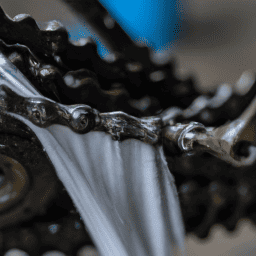
Cycling is a passion of mine, yet nothing detracts from a great ride more than a bicycle chain that’s dirty, gritty, or loud. Keeping the chain clean is crucial for the best performance and durability of the bike. However, for those new to it, the thought of cleaning a bike chain can be intimidating.
Don’t worry, though – in this article, I’ll walk you through the step-by-step process of how to clean a bicycle chain.
Before we dive in, let’s take a moment to understand why cleaning your bicycle chain is so important. Over time, dirt, dust, and grime can accumulate on your chain, causing it to wear out faster and perform poorly. A dirty chain can also negatively affect your bike’s shifting and braking, and can even make it harder to pedal.
By regularly cleaning your chain, you can extend its life, improve your bike’s performance, and enjoy a smoother, quieter ride. So, let’s get started!
Key Takeaways
- Regular chain maintenance can extend chain life and improve performance.
- Neglecting chain maintenance can lead to decreased performance, wear and tear, and rust buildup.
- Proper cleaning with degreaser and lubrication can reduce friction and wear.
- Removing the master link can make cleaning and lubrication easier, and reinstallation should be done properly using a chain tool and new quick link if necessary.
Understand the Importance of Cleaning Your Bicycle Chain
You need to understand why it’s crucial to clean your bike chain if you want to keep it in top condition. Regular chain maintenance offers several benefits, including smoother gear shifting, increased efficiency, and longer chain life.
If you neglect your chain, dirt, grime, and other contaminants will accumulate on it, leading to wear and tear that can cause it to stretch or break. A dirty chain also creates unnecessary friction, which can slow you down and make your ride less enjoyable.
To prevent chain wear and tear, there are a few tips you should keep in mind. First, avoid cross-chaining, which means using the largest chainring with the largest cog or the smallest chainring with the smallest cog. This puts extra stress on the chain and can lead to premature wear.
Second, shift gears smoothly and avoid sudden, jerky movements that can strain the chain.
Third, make sure your chain is properly lubricated to reduce friction and prevent rust buildup. With these tips in mind, you’ll be able to keep your bike chain in top shape and enjoy a smoother, more efficient ride.
Now, let’s move on to gathering the necessary supplies for cleaning your chain.
Gather the Necessary Supplies
First, grab a rag and a bottle of lubricant to prepare for the maintenance of your trusty two-wheeler. It’s important to have a clean rag to wipe off any dirt and grime from the chain, as well as a high-quality lubricant to keep it running smoothly. Additionally, you may want to invest in a chain degreaser to remove any stubborn build-up.
Proper storage of your bike also plays a crucial role in the longevity and efficiency of your chain. When not in use, it’s best to store your bike in a dry, cool place. This will prevent rust and minimize wear and tear on the chain.
With the necessary supplies on hand and a bit of care, you can ensure your bike chain stays in top condition. Now, let’s move on to the next step of removing the chain from your bike.
Remove the Chain from Your Bike
Now, it’s time to get down and dirty and wrench that stubborn chain off your bike like a biker boss. First, you need to locate the master link on your chain. The master link is the link that can be easily removed without the need for a chain tool. It usually has a clip or a pin that holds it in place. Check your chain for any chain wear indicators, such as stretched links or kinks, which may indicate that the chain needs to be replaced.
Once you’ve identified the master link, use a pair of pliers to remove the clip or pin that holds it in place. Gently wiggle the chain until the master link comes apart. Now, the chain is free from your bike. Be careful not to lose the master link and keep it somewhere safe. With the chain removed, you can now proceed to clean and lubricate it for optimal chain maintenance.
Without further ado, let’s dive into the next step of the process: clean and lubricate the chain.
Clean and Lubricate the Chain
To ensure smooth and efficient cycling, it’s important to regularly maintain the health of your bike’s chain by keeping it free of dirt and debris while also providing proper lubrication. Proper lubrication is essential for reducing friction and wear on the chain, allowing for smoother shifting and a longer lifespan for the chain. However, it’s important to avoid common mistakes such as over-lubricating, which can attract more dirt and debris, or using the wrong type of lubricant, which can lead to a buildup of gunk on the chain.
To properly clean and lubricate your bike’s chain, follow these steps:
- Use a degreaser to remove dirt and grime from the chain.
- Use a brush or rag to scrub the chain thoroughly.
- Wipe off any excess degreaser and let the chain dry completely.
Apply a small amount of lubricant to the chain, making sure to cover all the links. Wipe off any excess lubricant with a clean rag.
By following these steps, you can ensure that your bike’s chain is clean and properly lubricated, leading to a smooth and efficient ride. Now that the chain is clean and lubricated, it’s time to reinstall it and test your bike’s performance.
Reinstall the Chain and Test Your Bike’s Performance
Ready to feel the difference in your ride? Get your hands dirty and reinstall that chain, then take your bike for a spin to see how smooth and efficient it runs.
Before you start, make sure you’ve got all the necessary tools and equipment. This includes a chain tool, a new quick link, and a degreaser.
Once you’ve got everything you need, you can begin the chain maintenance process. Start by checking the chain wear indicators. If they’re showing signs of wear, it may be time to replace the chain altogether. If the indicators are still within the acceptable range, you can begin reinstalling the chain.
Use the chain tool to break the chain and remove it from the bike. Then, clean it thoroughly with a degreaser before installing the new quick link.
Finally, test your bike’s performance to make sure everything is running smoothly. If you encounter any issues, use troubleshooting tips to identify and resolve any problems.
With proper chain maintenance, your bike will run like new for years to come.
Frequently Asked Questions
What is the best way to store a bicycle chain when it’s not in use?
When not in use, I store my bicycle chain in a dry, cool place to prevent rust. Consistent chain maintenance is crucial to extend its lifespan. Regular cleaning and lubrication will prevent buildup and rust.
Can I use dish soap or other cleaning products to clean my bike chain?
Using dish soap to clean your bike chain can be effective, but it can also strip away lubrication and cause rust. Instead, try bike-specific degreasers or citrus-based cleaners. Always lubricate your chain after cleaning.
How often should I clean my bike chain?
Regular chain maintenance is crucial for optimal bike performance. Signs of a dirty chain include rust, grime buildup, and noisy gear shifts. Clean your chain every 100-200 miles or after riding in wet or muddy conditions.
Is it necessary to remove the chain from the bike in order to clean it?
To ensure optimal bike performance, chain maintenance is crucial. While cleaning the chain, I recommend removing it for a thorough cleaning. This allows for access to hard-to-reach areas and ensures a more effective cleaning process.
What kind of lubricant is best for bike chains?
For optimal performance, I recommend using a bike chain lubricant that is water-resistant. When it comes to spray vs oil, I prefer oil as it lasts longer. Apply the lubricant to the chain while rotating the pedals to ensure even coverage.
Conclusion
In conclusion, cleaning your bicycle chain is an essential task that shouldn’t be overlooked. Neglecting to clean your chain can lead to decreased performance, increased wear and tear, and even chain failure.
To clean your chain, gather all necessary supplies, including a chain cleaning tool, degreaser, and lubricant. Remove the chain from your bike before cleaning and thoroughly clean each link.
Once cleaned, apply a high-quality lubricant to the chain and reinstall it on your bike. Test your bike’s performance and make any necessary adjustments. By following these simple steps, you can keep your bike running smoothly for years to come.
Olivia’s writing is not only informative but also inspiring. She has a knack for telling stories that capture the essence of cycling and the joy it brings to people’s lives. Her writing has been praised by readers and industry experts alike for its clarity, depth, and authenticity.
In addition to her writing, Olivia is also an avid cyclist. She enjoys exploring new trails and routes and has participated in several cycling events and races. Her first-hand experience with cycling gives her a unique perspective on the sport, reflected in her writing.
Overall, Olivia is a talented writer passionate about cycling and dedicated to producing high-quality content for FlatironBike. Her contributions to the magazine have helped make it a go-to source for cycling enthusiasts worldwide.
Beach Cruiser
How To Put Motor On Bicycle
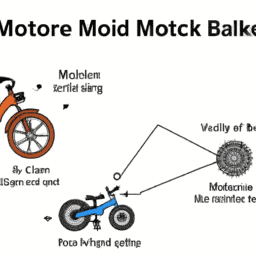
Imagine the scene: you’re cycling uphill, your brow drenched in sweat, legs aching from the effort. Out of nowhere, a slight buzzing noise catches your attention from behind. Glancing back, you spot another rider, smoothly ascending the hill on an electric bike with ease. A sense of envy inevitably creeps in.
But fear not, my friend! With the right tools and a bit of know-how, you too can transform your trusty bicycle into a motorized machine.
In this article, I’ll be sharing with you step-by-step instructions on how to put a motor on your bicycle. From understanding the different types of motors available to gathering the necessary tools and materials, we’ll cover everything you need to know to get your bike up and running with a motor.
So, grab a cup of coffee and let’s dive right in.
Key Takeaways
- There are two types of motors for bicycles: electric and gas-powered, each with their own advantages and disadvantages to consider.
- When choosing a motor type, factors to consider include personal preference, budget, and intended use.
- Proper installation of a motor requires tools such as wrenches, pliers, screwdrivers, and WD-40, as well as precautions such as wearing protective gear and ensuring the bike frame is cleaned and free from dirt.
- Safety is always a top priority when riding a motorized bicycle, including wearing protective gear, following traffic laws and signals, and being cautious in wet or slippery conditions.
Understand the Different Types of Motors Available
You gotta know the diff’rent types of motors you can use before you start puttin’ one on your bike.
There are two main types of motors available for bicycles: electric and gas-powered. Electric motors are powered by rechargeable batteries and are more environmentally friendly compared to gas-powered motors. They also require less maintenance and are relatively quiet. However, electric motors have limited range and require frequent recharging. They’re also more expensive compared to gas-powered motors.
On the other hand, gas-powered motors run on gasoline and are more powerful compared to electric motors. They have a longer range and can reach higher speeds, making them ideal for longer rides or off-road adventures. However, gas-powered motors require more maintenance and emit harmful gases into the environment.
Choosing the right motor type depends on your personal preference, budget, and intended use for the bike.
With that said, let’s move on to gather the necessary tools and materials.
Gather the Necessary Tools and Materials
Alright, first things first – grab your toolbox and make sure you’ve got everything you need to get started, like a wrench, pliers, and a screwdriver. And don’t forget to grab some WD-40 to loosen up any stubborn bolts or screws that might be giving you trouble.
Before proceeding, it’s important to understand that different types of bicycles require different types of motors. Therefore, make sure that you’ve researched and selected the appropriate motor for your specific type of bicycle. Additionally, it’s important to take safety precautions when working with a motor. Make sure to wear protective gear such as gloves, goggles, and a helmet to prevent any injuries that might occur during the installation process.
Once you have gathered all the necessary tools and materials, it’s time to prepare your bicycle for motor installation. This involves removing any unnecessary components such as the pedals, chain, and derailleur. It’s also important to clean the frame thoroughly to ensure that the motor can be installed properly.
By preparing your bicycle in this way, you’ll be able to install the motor with ease and ensure that your bike runs smoothly.
Prepare Your Bicycle for Motor Installation
Now it’s time to get your ride ready for some serious power, so roll up your sleeves and let’s make some magic happen!
Before installing a motor, it’s essential to prepare your bicycle by following some pre-installation steps. Firstly, make sure the surface where the motor will be installed is clean and free from any dirt, grease, or dust. A clean surface ensures that the motor is mounted securely and won’t come loose while riding.
Next, check your brakes and make sure they’re in good working condition. It’s crucial to have a reliable braking system when motorizing your bicycle to ensure your safety while riding.
Additionally, consider weight distribution when choosing the right motor placement on your bicycle. Placing the motor in an optimal position ensures that the weight is balanced and doesn’t affect the bicycle’s handling.
With these pre-installation steps completed, you’re now ready to install the motor and transform your bicycle into a powerful machine!
Install the Motor
Now that I’ve prepared my bicycle for motor installation, it’s time to move on to the next step: installing the motor.
This involves connecting the wires between the motor and the battery, testing the motor to ensure it’s working properly, and then securing it onto the frame of the bicycle.
It’s important to follow each of these steps carefully to ensure a safe and successful installation.
Connect Wires
First, you’ll need to connect the wires from the motor to the battery using the provided connectors. Before you start, make sure you have the right wire gauge selection for your motor and battery. Using wires that are too thin could lead to overheating and possible damage.
Once you have the right gauge, strip the ends of the wires and twist them together before inserting them into the connectors. Be sure to use proper insulation techniques such as heat shrink tubing or electrical tape to prevent any short circuits.
Next, it’s important to double-check your connections and make sure everything is secure. A loose connection could cause the motor to malfunction or even stop working altogether.
Once you’ve confirmed that everything is properly connected, it’s time to move on to the next step: testing the motor. With the motor connected to the battery, turn the throttle and see if the motor starts up smoothly. If it does, congratulations! You’ve successfully connected the wires and installed the motor on your bicycle.
Test Motor
After all the hard work of connecting the wires, it’s time to see if everything is functioning properly by testing the motor.
To begin, I should attach the motor to the bike’s rear wheel using the appropriate mounting system. Once that’s done, I can turn the bike upside down and spin the wheel by hand to check if the motor is spinning as well. If it is, then the motor is properly installed and functioning correctly.
If the motor isn’t spinning, then I’ll need to troubleshoot the issue. First, I should check the wiring connections to make sure they’re secure and properly connected.
If that doesn’t solve the issue, I can use a multimeter to test the voltage of the battery and the wires. If the voltage is correct, then the issue may be with the motor itself and I’ll need to take a closer look at it.
Once the motor performance is tested and confirmed, I can move on to securing the motor in place without any worries.
Secure Motor
Make sure your motor is locked in tight, so you can ride with confidence and feel the wind in your hair. There are several motor mounting techniques you can use to ensure your motor is secure on your bicycle.
One technique is to use a motor bracket that’s specifically designed for your type of motor. When choosing the right motor bracket, make sure it’s compatible with your bicycle’s frame and the size of your motor.
Another technique is to use metal clamps to hold the motor in place. These clamps can be tightened securely around the motor and the bicycle frame. Make sure the clamps are placed in a position that won’t interfere with the chain or any other moving parts of the bicycle.
Once you’ve securely mounted your motor, give it a shake to ensure it’s firmly in place.
With your motor now securely mounted, you can move on to the next step and enjoy your motorized bicycle!
Enjoy Your Motorized Bicycle!
Now that you’ve got your motorized bicycle, it’s time to hit the road and enjoy the ride! One of the benefits of having a motorized bicycle is that it can make commuting or running errands much easier and faster.
However, it’s important to remember to be safe while riding. Here are some tips for safe motorized biking:
- Firstly, always wear a helmet and other protective gear such as gloves and knee pads. This will help protect you in case of an accident.
- Secondly, make sure to follow traffic laws and signals, and stay in designated bike lanes when possible. Always signal your turns and be aware of your surroundings.
- Lastly, be cautious when riding in wet or slippery conditions, and avoid riding at night if possible.
By following these tips, you can enjoy your motorized bicycle while also staying safe on the road.
So, have fun and happy riding!
Having a motorized bicycle can be a great way to get around. It can save time and money while also being environmentally friendly.
However, it’s important to remember to be safe while riding. By wearing protective gear, following traffic laws, and being aware of your surroundings, you can enjoy your motorized bicycle to the fullest.
So, get out there and explore the world on your new ride!
Frequently Asked Questions
How fast can a motorized bicycle go?
I’ve found that the top speed of my motorized bicycle depends on factors like weight, terrain, and wind resistance. To optimize performance, I focus on acceleration and regularly maintain the engine. Safety considerations for high speed riding include wearing protective gear and obeying traffic laws.
Do I need a license to ride a motorized bicycle?
To ride a motorized bicycle, I need to check my state’s license requirements as they vary. Some states only require a regular driver’s license, while others need a special license or registration. Not having the proper license can lead to legal implications.
How much weight can a motorized bicycle carry?
I’ve found that the cargo capacity of a motorized bicycle can vary depending on the weight distribution. Generally, they can carry up to 200 pounds with proper balance and weight distribution.
Can I still pedal my bicycle with a motor installed?
I researched and found that a motorized bicycle can be equipped with either a pedal assist or throttle only installation. Pedal assist allows for pedaling while the motor provides assistance, while throttle only eliminates the need for pedaling. Each has its pros and cons.
How do I maintain and care for my motorized bicycle?
When it comes to motor maintenance, regular oil changes and air filter replacements are key. Troubleshooting tips include checking spark plugs and carburetor adjustments. It’s important to keep a toolkit handy and perform routine inspections to prevent larger issues.
Conclusion
Well, that’s it! I’ve successfully installed a motor on my bicycle and it’s a game-changer.
I feel like I’ve entered a new dimension of cycling. No more struggling up hills or arriving at work sweaty and tired. Now, I glide effortlessly through the streets, feeling like a superhero on wheels.
The installation process was surprisingly easy, especially with the right tools and materials. And the end result is simply amazing.
If you’re someone who loves cycling but wants a little extra power, I highly recommend putting a motor on your bike. Trust me, it’s worth every penny and every second spent on installation.
Olivia’s writing is not only informative but also inspiring. She has a knack for telling stories that capture the essence of cycling and the joy it brings to people’s lives. Her writing has been praised by readers and industry experts alike for its clarity, depth, and authenticity.
In addition to her writing, Olivia is also an avid cyclist. She enjoys exploring new trails and routes and has participated in several cycling events and races. Her first-hand experience with cycling gives her a unique perspective on the sport, reflected in her writing.
Overall, Olivia is a talented writer passionate about cycling and dedicated to producing high-quality content for FlatironBike. Her contributions to the magazine have helped make it a go-to source for cycling enthusiasts worldwide.
Beach Cruiser
How Are Bicycle Frames Measured
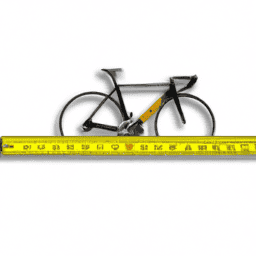
As an enthusiastic bicyclist, I’ve learned the critical role that the right bike frame size plays in cycling. Using a bike whose frame size doesn’t fit can cause discomfort, lower your cycling performance, and potentially lead to injuries. Therefore, it’s essential to be knowledgeable about accurately measuring your bike frame.
In this article, I will guide you through the process of measuring your bike frame. We will start by identifying the parts of a bike frame and understanding the importance of proper frame measurement. Then, we will move on to determining your ideal frame size and measuring your bike frame. Finally, I will provide some tips for adjusting your bike frame to ensure a comfortable and safe ride.
So, let’s get started!
Key Takeaways
- Proper bike frame measurement is important for comfort, performance, and injury prevention.
- Understanding parts and measurements, as well as choosing the right frame material, is crucial in determining the ideal frame size.
- Measuring techniques vary depending on the type of bike frame and factors affecting sizing include height, inseam length, and riding style.
- Adjusting the bike frame involves loosening bolts on the seat post and handlebars, and personal preferences and bike fit considerations should be taken into account.
Understand the Importance of Proper Frame Measurement
Proper frame measurement is crucial for ensuring a comfortable and efficient ride, so don’t skimp on taking the time to get it right! The importance of fit cannot be overstated.
When your bike frame is not properly measured, it can lead to an uncomfortable or even painful ride. Incorrect measurements can result in a number of issues, including poor posture, muscle fatigue, and even injury.
The impact of incorrect measurements can be felt not only in the short term but over the life of the bike as well. A poorly fitting bike can cause premature wear and tear on parts, leading to costly repairs or replacements. It can also affect your performance and enjoyment of cycling.
Taking the time to ensure proper frame measurement can make all the difference in your cycling experience. With a well-fitted bike, you’ll be able to ride longer, faster, and more comfortably.
Now, let’s move on to identifying the parts of a bike frame.
Identify the Parts of a Bike Frame
One key aspect of understanding a bike’s structure is being able to identify the various components of its frame. These components include the seat tube, top tube, down tube, and chainstays. Each of these parts has a specific function and contributes to the overall performance of the bike.
When considering a bike frame, it’s important to take into account the materials used and the frame geometry. Frame materials can vary from steel, aluminum, carbon fiber, and titanium, each with their own unique properties.
Frame geometry includes measurements such as the seat tube angle, head tube angle, and chainstay length. These measurements affect how the bike handles and performs in different scenarios.
Understanding the parts and measurements of a bike frame is crucial in determining your ideal frame size.
Determine Your Ideal Frame Size
Finding the perfect fit for your bike can make all the difference in your riding experience. There are several factors affecting sizing, including your height, inseam length, and riding style. To determine your ideal frame size, you’ll need to take measurements and consider these factors.
Choosing the right frame material is also important. Frame material affects the weight, durability, and overall performance of your bike. Common frame materials include aluminum, carbon fiber, steel, and titanium. Each material has its own unique characteristics, so it’s important to research and choose the one that best fits your needs.
Once you’ve determined your ideal frame size and material, you can move on to measuring your bike frame.
Measure Your Bike Frame
Now it’s time for you to get out your measuring tape and figure out the exact dimensions of your ride. Measuring your bike frame is important to ensure that you have a comfortable and efficient cycling experience.
There are several measuring techniques that you can use, depending on the type of bike frame you have. First, if you have a traditional diamond frame, you can measure the seat tube length from the center of the bottom bracket to the top of the seat tube. Another way to measure is to find the top tube length, which is the horizontal distance between the seat post and the head tube.
For sloping top tube frames, measure the virtual top tube length, which is the horizontal distance between the head tube and the seat post in a level position. Lastly, if you have a full suspension bike, measure the effective top tube length, which is the horizontal distance between the head tube and the seat post in a level position.
It’s also important to note that the measuring technique may vary depending on the material of your bike frame, as different materials have different properties that affect the measurements.
Now that you have measured your bike frame, it’s time to make any necessary adjustments to ensure that you have the perfect fit.
Adjusting Your Bike Frame
To adjust your bike frame, you’ll need to loosen the bolts on the seat post and handlebars. Make sure to use the appropriate tools and follow the manufacturer’s instructions.
Once the bolts are loosened, you can move the seat post and handlebars up or down and forward or backward to find the perfect position for your body. Adjusting techniques will vary depending on your personal preferences and bike fit considerations.
When adjusting your bike frame, it’s important to consider your riding style, body measurements, and flexibility. A proper bike fit can help prevent injuries and improve your overall riding experience. Experiment with different adjustments until you find the perfect fit for your body.
Remember to tighten the bolts securely after making any adjustments to ensure your safety while riding.
Frequently Asked Questions
What is the most common material used for bicycle frames?
As a bike enthusiast, I can tell you that the most common bicycle frame materials are aluminum, carbon fiber, and steel. Each has its own advantages and disadvantages, such as weight, durability, and cost. Choosing the right material depends on your riding style and budget.
How much does a typical bike frame weigh?
You might be thinking that a lightweight bike frame is weak, but that’s not necessarily the case. Bike frame materials like carbon fiber and aluminum can be both strong and lightweight, with a typical weight range of 1-3 pounds.
Can a bike frame be repaired if it is damaged?
When a bike frame is damaged, repair options depend on the severity of the damage and the material of the frame. Aluminum and carbon frames can be repaired, but it can be costly. Steel frames are easier and cheaper to repair.
Are there any safety considerations when measuring a bike frame?
Oh, measuring a bike frame is a piece of cake! Just grab a ruler and eyeball it. Who cares about accuracy and safety, right? In reality, precise measuring techniques are crucial for ensuring a safe and comfortable ride.
How often should a bike frame be replaced?
A bike frame’s lifespan depends on its material, usage, and maintenance. Signs of wear and tear include cracks, dents, and rust. I replace my bike frame when it becomes unsafe or no longer fits my needs.
Conclusion
In conclusion, measuring your bike frame is crucial for a comfortable and safe riding experience. It’s important to understand the different parts of a bike frame and how to determine your ideal frame size to avoid discomfort or injury.
Measuring your bike frame is a simple process that can be done at home with the right tools and following proper instructions. Remember the old adage, measure twice, cut once. This applies to bike frame measurement as well.
Taking the time to ensure accurate measurements will save you from the hassle of having to make adjustments later on. Adjusting your bike frame is also important for a customized fit that caters to your unique body measurements.
With the right knowledge and tools, measuring and adjusting your bike frame can be a fun and rewarding experience that leads to a more enjoyable ride.
Olivia’s writing is not only informative but also inspiring. She has a knack for telling stories that capture the essence of cycling and the joy it brings to people’s lives. Her writing has been praised by readers and industry experts alike for its clarity, depth, and authenticity.
In addition to her writing, Olivia is also an avid cyclist. She enjoys exploring new trails and routes and has participated in several cycling events and races. Her first-hand experience with cycling gives her a unique perspective on the sport, reflected in her writing.
Overall, Olivia is a talented writer passionate about cycling and dedicated to producing high-quality content for FlatironBike. Her contributions to the magazine have helped make it a go-to source for cycling enthusiasts worldwide.
-

 Vetted1 week ago
Vetted1 week ago12 Best Men's Cycling Bib Shorts for Comfort and Performance – Reviewed & Rated
-

 Electric Bike5 months ago
Electric Bike5 months agoHow To Turn Your Bike Into An Electric Generator
-

 Vetted1 week ago
Vetted1 week ago15 Best Fixed Gear Bikes for Urban Commuting and Stylish Riding
-
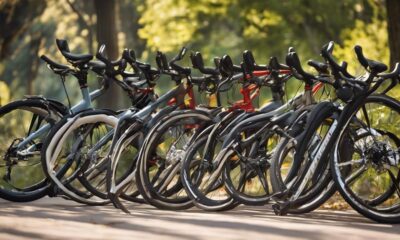
 Vetted1 week ago
Vetted1 week ago15 Best Comfort Bikes for a Smooth and Enjoyable Ride
-
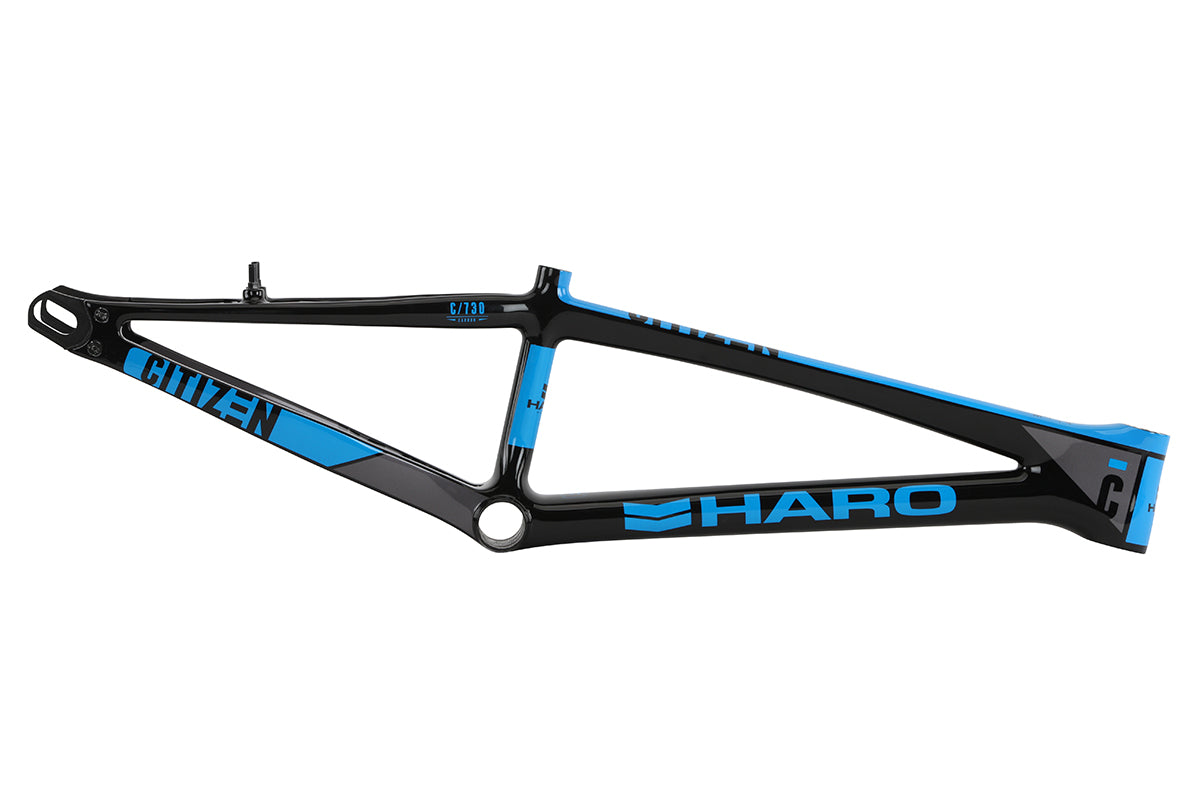
 Bike8 months ago
Bike8 months agoAdvantages and Disadvantages of a Carbon Fiber Bike Frame
-
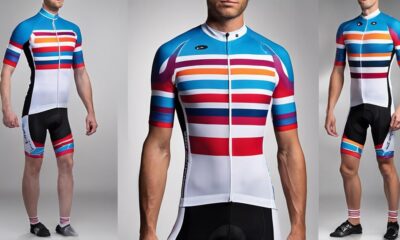
 Vetted1 week ago
Vetted1 week ago15 Best Cycling Jerseys for Men to Elevate Your Riding Game
-
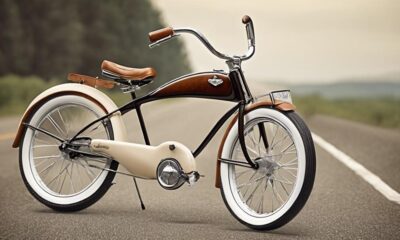
 Vetted1 week ago
Vetted1 week ago15 Best Cruiser Bikes to Hit the Road in Style
-

 Vetted1 week ago
Vetted1 week ago15 Best Cycling Gloves for Comfort and Performance – Ultimate Guide for Cyclists
